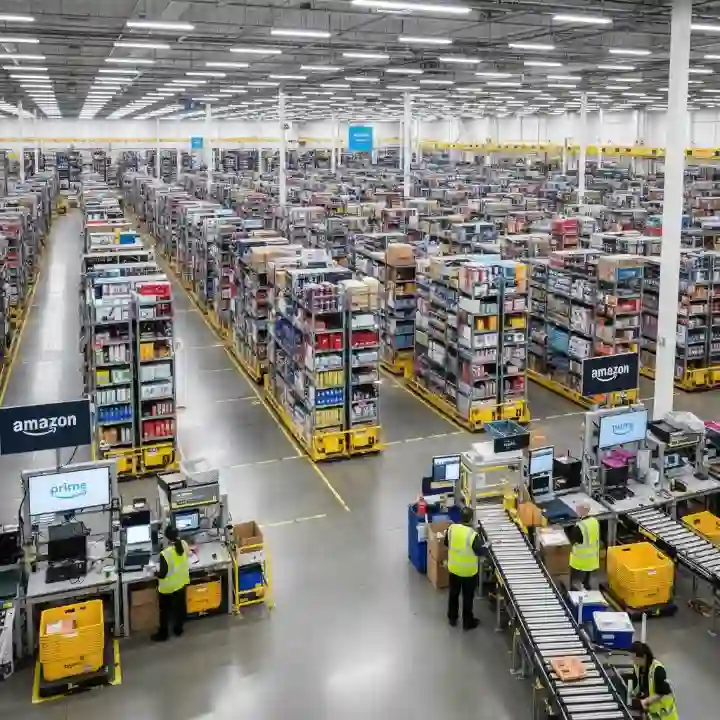The ticker AMZN is famous. Amazon.com, Inc. (NASDAQ: AMZN) is a source of both inspiration and debate for Wall Street pros and everyday investors. It changed from a small online bookstore to a huge e-commerce business and, by 2025, a major AI infrastructure company.
Why AMZN Still Matters
I recently heard two business owners discussing supply chain issues at a coffee shop. One said that without Amazon, his business would fail. Amazon is important not only for shopping but also for logistics, streaming, cloud computing, groceries, and smart home devices. By 2025, AMZN is more than just a ticker; it shows how technology, daily habits, and markets are connected.
AMZN’s Key Numbers for 2025
Market Cap: $2.41 trillion (September 2025)
Q2 2025 Revenue: $167.7 billion, up 13% year-over-year
Operating Income: $19.2 billion
Net Profit Margin: 10.5%
EPS (TTM): $5.14; Forward P/E: ~33.5
North America Revenue: $100.1 billion (+11% year-over-year); International: $36.8 billion (+11% year-over-year)
AWS Revenue: $30.9 billion (+17.5% year-over-year)
Amazon Ads: $15.7 billion (+22% year-over-year)
Amazon is currently the third-most valuable company in the world, behind Apple and Nvidia.
How AMZN Handles Growth and Challenges
For example, during the supply chain problems of 2023–24, a manufacturing CEO I spoke with moved all their direct-to-consumer distribution to Amazon. This showed both the good (wide reach, fast growth) and bad (lower profit margins, platform power) aspects. On the financial side, investors who simply owned AMZN as part of the Magnificent Seven stocks found its ups and downs less exciting than Nvidia’s rapid growth, but AMZN continued to grow steadily.
AMZN’s Business Model: E-Commerce, Cloud, Ads, and More
E-Commerce Still Important, but Margins Are Tight
Online stores make up about one-third of Amazon’s total revenue. Growth is moderate (+6% year-over-year), but it keeps the business running.
Logistics improvements: Amazon’s Prime same-day delivery and Buy With Prime options help it compete with Walmart and Shopify.
AWS: The Main Source of Profit
AWS now brings in $123 billion annually, with a 17% year-over-year revenue increase.
Operating margin: It was at 39% but is now at 35% due to cloud price competition from Microsoft Azure and Google Cloud.
Enterprise migration: 85%-90% of the world’s IT spending is still not in the cloud, giving AWS plenty of room to grow.
Ads and Other Revenue Sources
Amazon Ads: Up 22% year-over-year, now bigger than YouTube and almost as big as Google’s network business.
Prime Video: Using ad-supported streaming with new live sports deals (NASCAR, NBA potential) and TV bundles for households.
Pharmacy, Health, and Project Kuiper: These are still new, but pharmacy revenue is up 50% year-to-date on a large base.
Key Lessons from AMZN: Operations and Challenges
Key Points:
Profit margins are important: Managing costs in logistics, using automation (robotics, AI for supply chain), and layoffs have helped increase profit margins despite slower growth.
Diversify to survive: As the North American market matures, international and ad businesses keep the company growing.
AI in everything: From Alexa to warehouse robots to Aurora driverless delivery, AI is used throughout Amazon. It has become as much a cloud/AI company as a retailer.
Mistakes to Avoid:
Focusing only on growth: The stock is not as driven by momentum as Nvidia or Meta.
Ignoring competition: Amazon’s cloud share has dropped from 33% to 29% as Microsoft and Google have become more competitive.
Being too confident about Big Tech monopoly risk: Regulators, especially in Europe and the U.S., are closely watching Amazon’s data-focused business.
Analyst Opinions: Opportunities, Risks, and Price Targets
Wall Street is generally positive: 95% of analysts rate AMZN as a buy or strong buy, with an average price target of $251 (about 10% increase).
Main Risks: Uncertain tariffs, currency changes, and potential regulatory actions are mentioned in every earnings call.
Comparison: Among the Magnificent Seven stocks, Amazon performed the worst year-to-date, but its forward P/E ratio is nearly 40% lower than Nvidia’s, suggesting more potential for patient investors.
Smart Portfolio Strategies for AMZN
Don’t think of AMZN as just an e-commerce stock: AWS and Ads will drive profit margins over the next decade.
Watch quarterly trends: Profit margins, ad growth, and AWS share are better indicators than overall revenue.
Consider options strategies: Covered call spreads or cash-secured puts have been successful for income-focused investors.
Size positions for long-term growth: Amazon’s strength is its steady growth, not rapid gains.
Follow new projects: Keep an eye on Project Kuiper, ad-tech partnerships, and healthcare moves for early signs of new growth areas.
Authority and Trust
This information comes from Amazon earnings calls and filings, analyst reports from LSEG and Reuters, data from Nasdaq and Yahoo Finance, and insights from supply chain executives and industry analysts. Editorial independence is maintained, combining public filings, real-world observations, and data analysis for a complete picture.
Conclusion: Is AMZN Still a Good Core Portfolio Choice?
Amazon may not be the most exciting stock in the MAG7, but it still influences retail, cloud, streaming, and AI innovation worldwide. For investors seeking stability, variety, and exposure to different future growth areas, AMZN remains a good choice, despite its challenges and slower periods.
What do you think about AMZN? Share your investment strategy and experience in the comments. For help with portfolio balancing or income strategies, talk to a financial advisor with tech expertise before making any big decisions.





